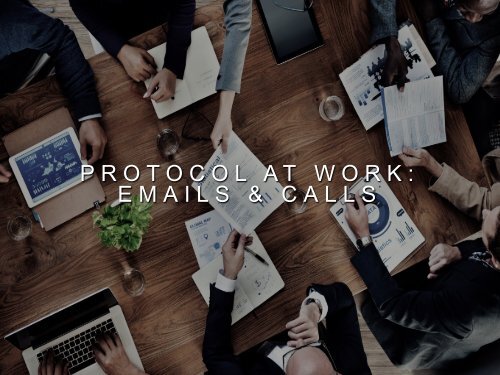Professional Protocol (ESCO)
Create successful ePaper yourself
Turn your PDF publications into a flip-book with our unique Google optimized e-Paper software.
PROTOCOL AT WORK:<br />
EMAILS & CALLS
EMAIL ETIQUETTE
USE A<br />
PROFESSIONAL<br />
SALUTATION
Use professional salutations and always assume the highest level of<br />
courtesy. Always address them appropriately. “Hi” and “Hello” are<br />
acceptable. When in doubt, always use “Dear”.
✗<br />
Hey
!<br />
Dear Mr Stark
✗<br />
Yo
!<br />
Hello Stark
USE OF<br />
SLANGS IN<br />
EMAILS
Avoid using shortcuts to real words or slang in your emails.<br />
Shortcuts such as “u" (instead of “ you"), "4" (for “for”) in businessrelated<br />
e-mail is not acceptable. Slangs should not be used in your<br />
professional emails. Any deviation has the potential to make you<br />
look less than professional.
✗<br />
How are u?
!<br />
How are you?
MISSPELLINGS
Proofread! Don’t confuse your reader. When in doubt, use the<br />
dictionary. Otherwise, consider rephrasing.<br />
Also, make an effort and use the appropriate words. For instance,<br />
know the difference between “their” and “they’re”, “you’re” and<br />
“your”.
✗<br />
They’re services
!<br />
Their services
CAPITALISATION<br />
OF PROPER<br />
NOUN AND<br />
PUNCTUATION
Courtesy also includes that you make the effort to communicate as<br />
educated and professionally as possible. Type in full sentences with<br />
proper sentence structure. Proper capitalization and punctuation are<br />
a must! Failure to capitalize when necessary suggest laziness or<br />
disinterest. None of which is positive for instilling confidence or<br />
encouraging others to conduct business with us, or you!
✗<br />
your brilliant<br />
lets proceed and i will update the team. their waiting for tis update.
!<br />
Let’s proceed and I will update the team. They’re waiting for this update.
BEWARE OF<br />
“REPLY ALL”
(We are all guilty of this, at times.) Use this with discretion! Do not<br />
hit "reply all" unless every member on the e-mail chain needs to<br />
know and that you are sure of this. You certainly do not want to<br />
include unintended recipients in your email.
EMAILING<br />
FROM MOBILE
Using mobile for business communication may result in sending<br />
emails with typos or formatting errors. Please consider informing<br />
your recipient of this by including a disclaimer.<br />
“Sent from my mobile. Please excuse the brevity of the message.”<br />
or similar.
BE IMAGE<br />
CONSCIOUS
Your e-mail is a reflection of you. Every e-mail you send adds to, or<br />
detracts from your reputation. If your e-mail is scattered,<br />
disorganized, and filled with mistakes, the recipient will be inclined<br />
to think of you as an unprofessional or disorganized<br />
businessperson. Unfortunately, other people's opinions do matter<br />
and in the professional world, their perception of you will be critical<br />
to your success as well.
CALL ETIQUETTE
IDENTIFICATION
Always identify yourself to the caller.
✗<br />
“Hello.”
!<br />
“Hello. Good afternoon,<br />
this is <strong>ESCO</strong>/Stark speaking.”
BE<br />
PROFESSIONAL
Maintain a level of professionalism throughout the entire<br />
conversation. After all, you are agents / face of the company. Your<br />
interaction with the caller may determine the caller’s impression of<br />
the company. A lackluster interaction suggests a lack of interest or<br />
commitment.
BE INTERESTED
Do not sound distracted or disinterested in the call. If needed,<br />
reschedule the call instead of creating the wrong impression to your<br />
caller. Put yourself in the shoes of your caller and think about how<br />
you would like to be spoken to if you’re calling in as the customer.
CLOSING THE<br />
PHONE CALL
Thank the caller for calling in! Be courteous.
TRANSFERRING<br />
CALL
While we all take the courtesy to inform the caller on why you're<br />
transferring, the same respect should be given to your colleagues<br />
instead of blindly transferring without any message to them.<br />
Moreover, you wouldn't want to frustrate your caller by having your<br />
teammate asking the same set of questions that you have asked.<br />
This will also give your teammate the chance to prepare for the call.<br />
Put yourself in the shoes of the caller and your teammate. Your<br />
innocent teammate may very well be on the receiving end of the<br />
customer's frustration / annoyance. This can be prevented if you<br />
could spare 2-3 minutes explaining the call just as you made the<br />
transfer.<br />
Proper business telephone etiquette can make a positive impressive<br />
on our callers and among ourselves.
1 Explain why<br />
Explain to the caller why you need to make the transfer.<br />
(It could be caller has reached the wrong department or you do not have the<br />
authority/information that the caller is seeking for).
2 Give your info first<br />
Give the caller your name and extension in case you get disconnected. This<br />
will also give the caller a sense of importance and that you are personally<br />
concerned about the caller's situation. And, remember to always be<br />
pleasant.
3. Ask Permission<br />
Ask the caller for permission to initiate the transfer.<br />
This will also give the caller a chance to ask other questions, if any.
4. Wait for an answer<br />
(from your teammate!)<br />
Do NOT blindly transfer the call as soon as you hear the other phone ring.<br />
Wait for the other person to answer and explain to them the reason for<br />
the call.
5 Complete<br />
the Transfer<br />
At this point, you can complete the transfer by connecting the caller and your<br />
teammate by hanging up your phone.
PROPER ETIQUETTE GOES A LONG WAY,<br />
SO LET'S ADOPT THIS HABIT.







